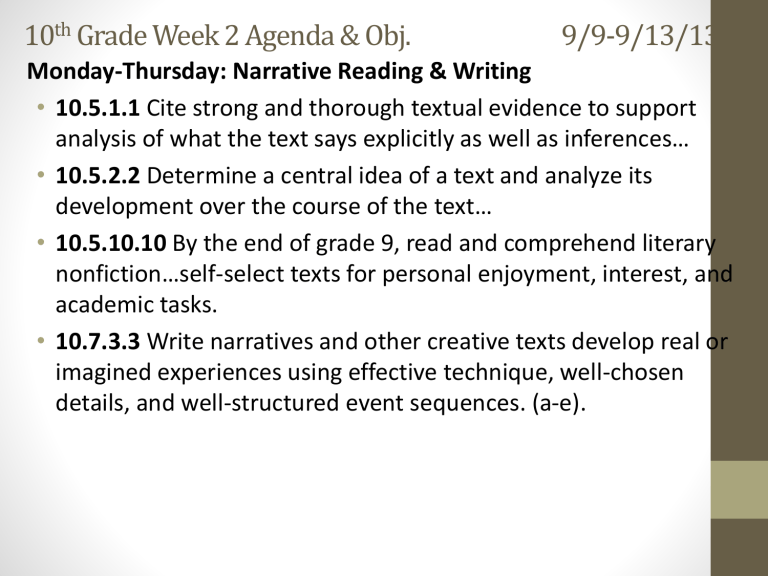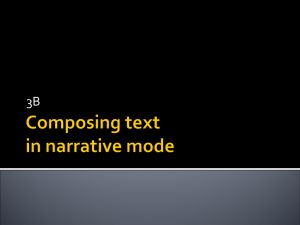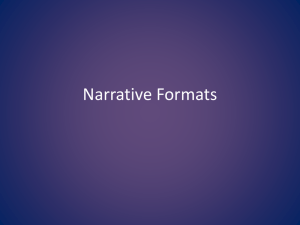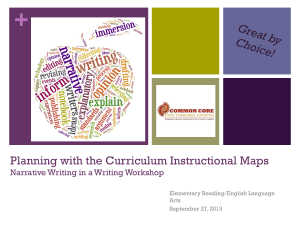File - Larson`s HS Class

10 th Grade Week 2 Agenda & Obj. 9/9-9/13/13
Monday-Thursday: Narrative Reading & Writing
• 10.5.1.1 Cite strong and thorough textual evidence to support analysis of what the text says explicitly as well as inferences…
• 10.5.2.2 Determine a central idea of a text and analyze its development over the course of the text…
• 10.5.10.10 By the end of grade 9, read and comprehend literary nonfiction…self-select texts for personal enjoyment, interest, and academic tasks.
• 10.7.3.3 Write narratives and other creative texts develop real or imagined experiences using effective technique, well-chosen details, and well-structured event sequences. (a-e).
Daily Writing: Embarrassing 09/09/13
• Most formal paragraphs consist of at least 4-6 good sentences. Usually, the first sentence is the
topic sentence. Practice writing a solid paragraph with a topic sentence and several supporting sentences. Write on the topic of your most
embarrassing moment.
Planner:
Due tomorrow:
• Title: Current Events Sept. Wk1
Due tomorrow if not done by EOC:
• Journal title: My Narrative Timeline
Due Thursday:
• Journal title: My Narrative 1 st Draft
Monday: Narratives
1.
Show me your Prewriting for
Narrative as you share with a friend.
2.
Do you remember the 6 Traits of
Writing from last year???
Notebook title: The 6 Traits of Writing
A great piece of writing has all of these important traits:
1.
Ideas & Content
2.
Organization
3.
Word Choice
4.
Sentence Fluency
5.
Voice
6.
Conventions
Plus one… Presentation!
#1: Ideas & Content
This is the HEART of the story/paper.
A writer should:
• Have a specific topic
• Use a fresh, original perspective
• Have a position that’s clear, developed and supported by EVIDENCE.
• Write from experience
• Use important, interesting details
#2: Organization
The structure & pattern of writing. A writer should:
~ use inviting lead that hooks the reader
~ use logical and effective order
~ use smooth transitions
~ place supporting details where they are most appropriate
~ use a conclusion that gives the reader a sense of resolution (clincher)
#3: Word Choice
“ Strong word choice clarifies and expands ideas…moves and enlightens the reader.
”
~Northwest Regional
Educational Laboratory
“ Don’t tell me the moon is shining; show me the glint of light on broken glass.
”
~Anton Chekhov
#3: Word Choice (cont…)
A writer should:
~ Use words that create a mental picture for the reader
~ Use powerful action verbs (vivid verbs)
~ Use specific nouns and adjectives
~ Use language that is natural and not overdone
~ Be concise (tighten sentences)
~ Use words correctly
~ Avoid repetition, slang, and clichés
#4: Sentence Fluency
“ To me the greatest pleasure of writing is not what it’s about, but the music the words make.
”
--Truman Capote
#4: Sentence Fluency
A writer should:
~Vary sentence beginning, structure, and length
~ Use complete sentences
~ Use transitions (internal & external) to promote cadence
#5: Voice
“ It is the heart and soul of the writing, the magic, the wit, the feeling, the life and breath.
”
--Northwest Regional
Educational Laboratory
This is where the paper comes to LIFE through lively, expressive and engaging writing.
#5: Voice
A writer should:
~ Write honestly and from the heart
~ Interact with the reader without using “you” or “I”
~ Use language that brings the topic to life
~ Care about topic
~ Use expression to voice personality
#6: Conventions
A writer should:
~ Turn in a clean, edited, and polished final draft
~ Reinforce the organization with good paragraphing
~ Use correct punctuation, spelling, and grammar
Monday: Narratives
As you draft your narrative, we’ll focus on the different traits. For today, let’s focus on narrowing your topic and brainstorming the “ideas” part of trait #1 (ideas & content).
1.Go through narrative assignment description & rubric.
2. Share your places with a partner.
Write down questions your partner has about your stories under
“prewriting for narrative.”
Monday: Narratives
3.Journal title: My Narrative
Timeline
Choose one memory and create a detailed record of events by making a timeline. Note also the significance of each event.
Reminder: Write a 2-3 page draft of your narrative by Thursday.
Journal title: My Narrative 1 st Draft
4.Move on to reading narratives…
Monday/Tuesday: Narratives
4. Continue to make predictions and look at the author’s perspective with Occupation:
Conductorette on page 76.
5. Journal title: Occupation:
Conductorette
Answer the After You Read questions (Literary Analysis,
Reading Skill & Vocabulary).
Daily Writing: Supposed to 09/10/13
When we’re talking, we say “suppose to,” instead of the grammatically correct way
“supposed to.” Burn this rule into your brain by writing 4 sentences correctly.
Write 1 sentence about pit bulls, 1 about politicians, 1 about pears and 1 about friends.
Planner:
Due Thursday:
• Journal title: My Narrative 1 st Draft
Tuesday: Narratives
1.
Hand in your current events HW.
2.
As I conference with individual students about his/her narrative:
• Continue reading & looking at author’s purpose with Occupation: Conductorette
(page 76).
• Title: Occupation: Conductorette
Answer the Critical Thinking ?s on page 84 and the After You Read questions (Literary
Analysis, Reading Skill & Vocabulary) on page
85 (skip 4b). Due at the end of the period.
• If you’re done early, work on your 2-3 page narrative due Thursday.
Daily Writing: Sept. 11 th 09/11/13
Choose one prompt to respond to and explain with detail:
• Where were you when the September
11 th attack happened? Describe your story.
• What is your opinion of the civil war in
Syria? Should the US get involved?
• Is “Civil War” an oxymoron? Explain.
Planner:
Due tomorrow:
• Journal title: My Narrative 1 st Draft
Wednesday: Narratives & Info Texts
1.
Discuss Occupation: Conductorette.
Hand it in for credit.
2.
15 mins: On a separate piece of paper, take the Test Practice:
Reading quiz (pg. 88 & 89).
1.
When you’re done, raise your hand and I’ll collect it.
2.
Work on
your narrative!
Journal
title: My Narrative 1 st Draft
Daily Writing: Hemingway 09/12/13
Choose one prompt to respond to and explain with detail:
• “I like to listen. I have learned a great deal from listening carefully. Most people never listen.” ~Ernest Hemingway
• “I know only that what is moral is what you feel good after and what is immoral is what you feel bad after.” ~Ernest Hemingway
Planner:
• Due tomorrow: Finish “A Neat Trick” handout and “Tell-Show” handout.
Thursday: Narratives
1.
Show me your draft!
2.
It’s all in the details! (#1 trait)
• Details are the answers to questions a reader might have. Your audience may understand your ideas but want to know more about them. Readers are curious!
Keep them interested!
• Go through Idea-Details chart
• Journal title: My Detail Brainstorming
• 5 mins: Create a chart in your journal & write sentence/idea from your narrative. Then write more details about it in the details column.
Thursday: Narratives
15 mins
Journal title: Details from Peers
1.
Draw a similar chart in your journal.
2.
Choose at least three sentences/ideas that you think you may need more detail on and write them in the Ideas column.
3.
Walk around the room and read your sentence to peers. Peers should ask questions about your ideas (think who, what, why, where, when, feelings, sights, thoughts, opinions, attitudes, etc.). The answers you tell them, write them down in your Details column.
Thursday: Narratives
15 mins
Journal title: Details from Peers
1.
Draw a similar chart in your journal.
2.
Choose at least three sentences/ideas that you think you may need more detail on and write them in the Ideas column.
3.
Walk around the room and read your sentence to peers. Peers should ask questions about your ideas (think who, what, why, where, when, feelings, sights, thoughts, opinions, attitudes, etc.). The answers you tell them, write them down in your Details column.
Thursday: Narratives
1.
Go through “A Neat Trick” handout and “Show not Tell” handout.
1.
Pick at least two details from your finished “Ideas-Details” chart and create details on your details!
2.
Pick at least two “tell” statements in your paper and turn them into
“show” statements.
Finish these by tomorrow what you don’t get done in class.
Daily Writing: Friday the 13 th !
09/13/13
Choose one prompt to respond to and explain with detail:
• What are you superstitious about? Explain.
In what ways are your friends, neighbors, and characters superstitious? Explain.
• Start a scary story!
Planner:
• Due Tuesday:
• OMM Vocab Chapter 1 Worksheet
Due Wednesday:
• Title: Current Events Sept. Wk 2
Friday: Of Mice and Men Introduction
1.
Show me your details & show handouts. Bring these Monday*!
2.
Start novel study: Of Mice & Men by John Steinbeck.
3.
Go over vocab worksheet due
Tuesday.
FYI, Monday we’ll go to the computer lab.
Make sure to come to class with your journal (that should have your rough draft) and your details & show handouts.
Friday: Intro to OMM
John Steinbeck
• 1902-1968
• Born in Salinas, California
• Steinbeck worked the fields while in college picking strawberries, lettuce, sugar beets and broccoli
• Published his first book Cup of Gold (1929), received first literary success in his book Tortilla
Flats (1935)
• Of Mice and Men is a novella written published in 1937. It is the tragic story of George Milton and Lennie Small, two migrant workers, who move from place to place in search of work during the Great Depression.
Friday: Intro to OMM
John Steinbeck
• Notebook title: Context of OMM
• Draw a KWL chart in your notebook (3 columns).
• Take a minute to write down what you
Know about The Great Depression.
• Then, write down questions for what you
Want to know.
• Watch an introduction to OMM and one specifically on The Great Depression:
• http://www.youtube.com/watch?v=emATt2VysZI&sns=em
• http://www.youtube.com/watch?v=TpfY8kh5lUw
• Finally, write down what you Learned about
The Great Depression.








